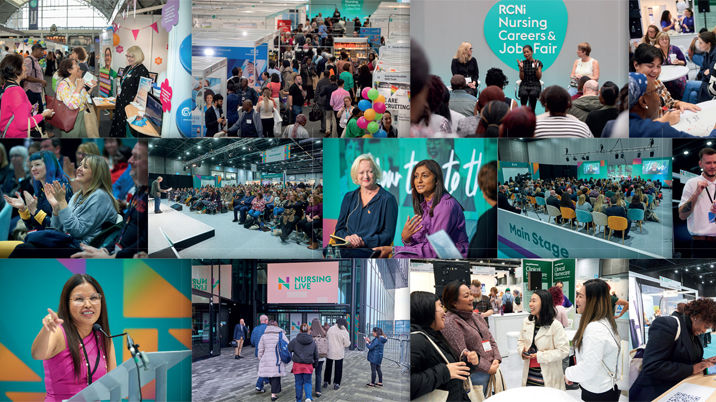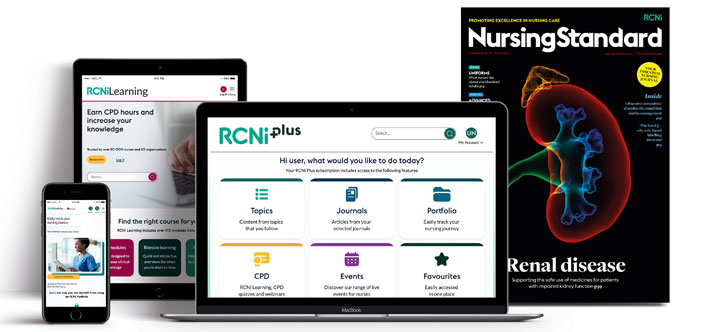
RCNi — publisher of ten nursing journals including Nursing Standard, winner of the PPA’s Chairman’s Award in 2021 — has become expert in product development and personalisation over the past decade. Now, it is working to build on both, extend its reach and revenue internationally, develop new partnerships, and capitalise on AI.
“We don’t have targets as such,” says Rachel Armitage, RCNi managing director. “We do have a clear role to fulfil, however.”
RCNi is a wholly owned subsidiary of the Royal College of Nursing (RCN), the world’s largest nursing union and professional body, which represents nursing staff in the UK and internationally and works to influence governments and other bodies, improve working conditions, and campaign on issues to raise the profile of the nursing community.
“We are here to support the people that subscribe to our products and services — those among the RCN’s 550,000 members that are subscribers, other subscribers working in the wider nursing professions who are not RCN members, and the many more also attending our events — as a life-long learning partner,” she continues.
“Any surplus we make goes back to the RCN.”
To this end, RCNi publishes journals, with clinical articles which are evidence-based and peer-reviewed, and a wide portfolio of educational and learning content to further support professional development while its events help develop careers and enhance nursing practice.
“Our content and how to optimise it to drive engagement and paid subscriptions is at the heart of everything we do,” Armitage explains. As is a clear-eyed focus on differentiation, utility, and experience — the new rules of audience engagement, for which all publishers, scientific and academic publishers especially, must now adapt.
Revenue diversification
When Armitage joined RCNi in 2015 from Elsevier, where she was director of eEducation Health Services following more than a decade at BMJ Publishing, one of her priorities was to diversify RCNi’s revenue stream — which back then came mainly from personal subscriptions.

So, one of her first moves was to set up a product development and product management function. A number of digital tools tailored to the specific wants and needs of RCNi’s audience then followed.
First off the blocks was RCNi Portfolio — a digital tool that integrates not just RCNi journals and learning content but also other content nurses might use.
As the glue between different education and professional development materials, RCNi Portfolio helps nurses navigate the revalidation process — storing and recording evidence of learning they must log three-yearly to nursing regulator the NMC.
Next came RCNi Learning — an online learning on demand tool with learning modules that support continuous professional development. Then, RCNi Decision Support — a decision support tool for use at point of care designed to improve decision-making by providing access to evidence and expert advice.
In 2021, she oversaw the launch of RCNi Plus — a single subscription proposition offering access to journal content, learning content and RCNi Portfolio — and Nursing Standard spin-off Nursing Standard Student to meet early career needs.
Over the same period, RCNi also significantly expanded its events portfolio. It will stage around 35 events this year, ranging from major careers fairs such as Nursing and Careers Job Fair to clinical issue-themed webinars.
Event strategy, meanwhile, evolved. It is now underpinned by a philosophy of event-based engagement and community-building, with an emphasis on peer-to-peer collaboration and — since the pandemic — more holistic ‘support’, meaning not just professional development but also mental and physical well-being and lifestyle.
Clear proposition
Key to RCNi’s successful product development has been clarity — about the needs to be served and the pain points to be addressed.
“You also need to really understand your value proposition, to not let the urge to get to market quickly persuade you to skip on concept and prototype development, and to meet the needs of the many by avoiding the temptation to over-engineer,” Armitage continues.
“Make sure that you’ve tested the price points. Can people afford it? Is it actually going to deliver value? What’s the price elasticity kind of look like? And then understanding the channel to market — who controls it, and how do you get there?”
It’s not just about the product, however. Nor is it just about the sale.
“You’ve got to be able to understand how people will access it, buy it, use it, who are the key decision makers, what are the triggers to buy? And you’ve also got to be able to distribute it,” she continues.
“You can’t just launch a digital product and leave it. Effective onboarding is important for retention and acquisition, to drive usage and repeat business. It’s about continuously refining and understanding user needs and adapting accordingly.”
All of which built on an intimate understanding of your audience and what they want and need.
“As well as working to ensure we reflect the diverse nature of the nursing workforce and make sure diverse voices are represented within that, we work to ensure all we do reflects new nursing roles and changes in policy as they emerge,” Armitage observes.
“We’ve had to be really disciplined in understanding the needs and pain points of different roles and career development stages in nursing and adapted our content accordingly.”
As, obviously, one size does not fit all, she adds, investment has been in products and services and systems to enable and deliver the personalisation this requires. And effective personalisation comes from focusing on the fundamentals.
“You’ve got to make sure any product you are developing is easy and quick to access and use and available across different channels and in different formats to meet different kinds of learning styles and needs,” she says.
“We looked at how consumer publishers were delivering and meeting the needs of their customers and worked with an external consultancy to look at evidence from around the world in terms of what worked and what doesn’t work.
“And it all goes back to delivering a compelling end user experience.”
As a result, nine years on and RCNi revenue is now split 50:50 between personal subscriptions and sponsorship, exhibition revenue and advertising. And attention now is on how to grow reach further — not just in the UK but also internationally.
Overseas revenue currently accounts for 10% of RCNi revenue — a proportion she hopes to increase while also growing the total revenue cake.
To achieve this, RCNi will work closely with the RCN — which is now developing plans for a Royal College of Nursing Institute of Nursing Excellence to drive improvements and innovation in nursing, including by strengthening nursing collaboration and knowledge globally.
“Together, we’ve obviously got much greater reach and influence. We will also collaborate to develop new audiences and products with other partners — aggregators, agents, third-party content creators and big tech,” she predicts. “We can’t do this alone. Partnerships will be the key to success.”
Exploring AI’s possibilities
Working with partners, she also hopes to advance RCNi’s approach to and use of AI.
“The impact of AI can’t be overstated — both in terms of its opportunity and also in terms of potential threat,” Armitage says.
On the upside, she cites ways AI in content creation and production can improve efficiency and productivity, freeing time and resources to focus on product enhancements and create better experiences and usability.
“We already use a variety of tools for editing purposes — subtitling videos, etcetera,” she explains. “And there are some really exciting tools that can be used to deliver an expanded range of content formats — interactive infographics, for example, or automated summaries to improve accessibility.”
Also in her sights are tools that can generate Q&A-style content out of sources such as RCNi webinars, video, or audio content like podcasts.
“When you start to look at the possibilities of what AI tools can now offer, their potential to deliver compelling end user experiences is really exciting,” Armitage adds.
“Another interesting area is how can it improve search and discovery. So, we’re piloting a tool where you can type in a question and it will return answers and links and references all from our own content, even guiding you to the actual source.”
With nurses so short on time, she continues, they want to be able to access RCNi content in multiple formats quickly and easily, confident that if they want to drill down to the evidence base that they will find it as RCNi has already done the hard work.
Even so, the threats of AI are many.
“Our content is high quality and peer reviewed and our brand lives or dies on that,” she says firmly.
“AI’s threats are around integrity of content, copyright, provenance, privacy, data, fake news. All of these and more will drive — and is driving — a change in terms of how organisations such as us position ourselves in the market. And we really need to adapt to that quite quickly.”
Partnerships with AI providers or using AI tools or striking any kind of AI-related licensing deals are necessary but should only be entered into with eyes wide open, Armitage warns.
“You have to adapt, but you must do so in a measured and informed way,” she says.
“Large language models, for example, could be a revenue opportunity for publishers like us. But working with technology providers that control access to markets and channels could lead to you losing all of your content and all of your value if protections are not in place.”
Science and academic publishing is at a critical juncture, she believes, with a number of business models no longer fit for service.
“We need to be more inclusive, more representative of different voices, more flexible, more agile — and we need to deliver great user experience for stakeholders as the power balance is shifting,” she says. And the key to navigating such challenges and more, aside from quality, is transparency.
“Generative AI is really easy now — just use ChatGPT and get information about anything. But what you don’t know is where does it come from, is it trusted, is it true?” she continues.
“In a huge sea of information, transparency will be really important for publishers to differentiate themselves and for the best content to stand out. As publishers, we need to identify where AI tools have been used — whether that’s in the production process, or to generate a summary — and be clear about what content has been touched by it and how.
“The key business driver is our brands and the quality of content we produce and the trust people have in them.”

This article was first published in InPublishing magazine. If you would like to be added to the free mailing list to receive the magazine, please register here.












